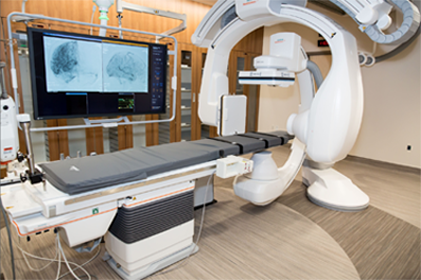
Interventional Radiology: Improving Health Outcomes in Farmington
Interventional Radiology Farmington
Interventional Radiology Farmington is a subspecialty within the field of radiology that involves the use of minimally invasive procedures to diagnose and treat a wide range of medical conditions. It has revolutionized the way healthcare providers approach certain diseases and has improved the quality of life for many patients in Farmington and beyond.
What is Interventional Radiology?
Interventional Radiology Farmington is a branch of radiology that uses imaging guidance, such as X-rays, CT scans, and ultrasound, to perform minimally invasive procedures to diagnose and treat various conditions. These procedures are performed using thin, flexible tubes called catheters, which are inserted through small incisions or punctures in the skin. The catheter is guided to the area of the body being treated using imaging guidance, and once in place, the interventional radiologist can perform a variety of procedures, such as injecting medications or performing biopsies.
The Benefits of Interventional Radiology:
One of the major benefits of interventional radiology is its minimally invasive nature. Unlike traditional surgical procedures, which often require large incisions and extended recovery times, interventional radiology procedures are typically performed through small punctures or incisions. This results in less pain and scarring, and a quicker recovery time for patients.
Another advantage of interventional radiology is that it can often be performed on an outpatient basis, allowing patients to return home the same day. This is particularly beneficial for older patients or those with other medical conditions that may make traditional surgery more difficult.
In addition to being minimally invasive and convenient, interventional radiology has also been shown to be highly effective in treating a wide range of medical conditions. For example, interventional radiologists can use embolization to block the blood supply to cancerous tumors, effectively shrinking the tumor and relieving symptoms. They can also use image-guided biopsy to obtain tissue samples for diagnosis, avoiding the need for exploratory surgery.
The Latest Advances in Interventional Radiology in Farmington:
Farmington is home to several highly regarded interventional radiology practices, and they are at the forefront of the latest advances in this field. These practices are equipped with state-of-the-art technology and staffed by highly trained interventional radiologists, who are committed to providing the best possible care to their patients.
One of the latest advances in interventional radiology is the use of image-guided biopsy to diagnose and treat cancer. Interventional radiologists can use CT scans or ultrasound to guide a biopsy needle to the area of the body being tested, allowing them to obtain tissue samples for analysis without the need for traditional surgery.
Interventional Radiology Farmington Services:
Another exciting development in interventional radiology is the use of embolization to treat cancer. By blocking the blood supply to a tumor, interventional radiologists can effectively shrink the tumor and relieve symptoms, making it an important tool in the fight against cancer.
Finally, interventional radiology is also playing an increasingly important role in the treatment of heart disease. Interventional radiologists can use angiograms to visualize the blood vessels of the heart, and they can perform a variety of procedures to improve blood flow, such as angioplasty or stenting.
Conclusion:
Interventional radiology has revolutionized the way healthcare providers approach certain diseases, and it has improved the quality of life for many patients in Farmington and beyond. With its minimally invasive nature, convenience, and effectiveness, interventional radiology is poised to play an increasingly important role in the future of healthcare. If you are in need of medical care, consider speaking with an interventional radiologist to learn more
Interventional Radiology Farmington How Its Work?
How Interventional Radiology Works in Farmington:
Interventional radiology is a subspecialty within the field of radiology that uses minimally invasive procedures to diagnose and treat a wide range of medical conditions. It is performed by interventional radiologists, who are trained in both radiology and minimally invasive procedures. Interventional radiology procedures are performed using imaging guidance, such as X-rays, CT scans, and ultrasound, and often involve the use of thin, flexible tubes called catheters.
Here is a step-by-step explanation of how interventional radiology works in Farmington:
- Imaging guidance: Before the procedure begins, the patient undergoes imaging, such as a CT scan or ultrasound, to get a detailed view of the inside of their body. The imaging helps the interventional radiologist to determine the best way to access the area of the body that needs to be treated.
- Puncture or incision: Depending on the type of procedure, the interventional radiologist will make a small puncture or incision, typically through the skin. This allows them to insert a thin, flexible catheter into the body.
- Catheter placement: Using imaging guidance, the interventional radiologist guides the catheter to the area of the body being treated. Once the catheter is in place, it can be used to perform a variety of procedures, such as injecting medications or performing biopsies.
- Procedure: The interventional radiologist uses the catheter to perform the procedure, which may involve injecting medications, taking biopsies, or performing other procedures. They will use imaging guidance to monitor the progress of the procedure and make sure that it is performed correctly.
- Recovery: After the procedure, the patient will rest in a recovery area for a short period of time. The puncture or incision will be covered with a dressing, and the patient will be able to return home the same day.
Interventional radiology procedures are minimally invasive and typically result in less pain and scarring, and a quicker recovery time, compared to traditional surgical procedures. They are performed in a specialized interventional radiology suite and use the latest technology and equipment, ensuring the best possible results for patients.

If you want to get amazing benefits by using this link
Do I Need A Dr. Referral Farmington
Conclusion:
In conclusion, interventional radiology is a highly effective and minimally invasive way to diagnose and treat a wide range of medical conditions. If you are in need of medical care, consider speaking with an interventional radiologist in Farmington to learn more about the procedures and benefits of interventional radiology.



